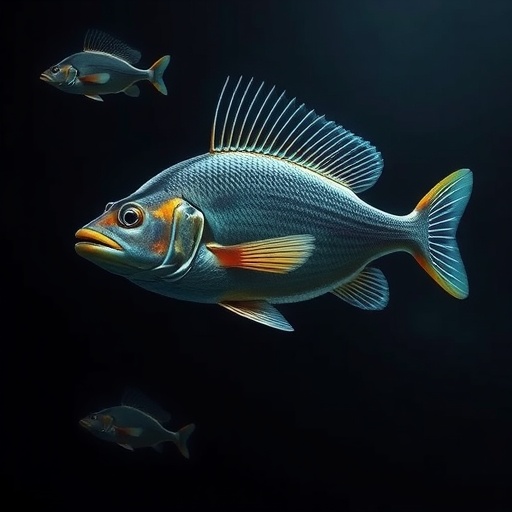The deep ocean, encompassing nearly 90% of the world’s marine volume, has long been regarded as a vast, uniform expanse shrouded in darkness. However, recent research challenges this oversimplified view, revealing an intricate tapestry of ecological diversity that shapes the evolution of fish species beneath the waves. A groundbreaking study published in the journal Evolution has uncovered how deep-sea fish have developed a remarkable diversity of body shapes driven by the complex interplay of habitat and evolutionary mechanisms.
Elizabeth Santos, an assistant professor of evolution, ecology, and organismal biology at The Ohio State University, led a comprehensive analysis that included nearly 3,000 species of ray-finned fishes dwelling at depths greater than 200 meters. This research provides unprecedented insight into how environment-specific factors influence morphological evolution in one of Earth’s most mysterious frontiers—the deep sea.
The core revelation of the study is the stark contrast in body shape diversity between pelagic fishes—those inhabiting the open water column—and benthic fishes that dwell on or near the ocean floor. Pelagic species exhibit an extraordinary range of morphologies, from the compact, bulbous form of anglerfish to the slender, elongated bodies of eels. This stands in sharp contrast to their benthic counterparts, who predominantly possess uniform, tapered bodies adapted for life on the muddy and relatively unstructured deep-sea substrate.
Santos explains that the divergent evolutionary pressures in these environments result in fundamentally different pathways of body shape diversification. For pelagic species, colonization events by distantly related lineages appear to introduce a rich variety of body plans. Such colonization leads to genetically diverse assemblages where species have evolved distinct morphologies suited to fluctuating prey availability and the whims of the deep-sea water column’s physical conditions.
In contrast, the benthic environment’s evolutionary trajectory appears more linear, dominated by fewer lineages persisting for extended periods. This leads to a convergence of morphological traits as species adapt to similar constraints, such as locomotion and camouflage in a relatively homogenous, low-light, and nutrient-scarce benthic landscape. The research suggests that the benthic fishes’ evolution is characterized by more rapid, localized adaptation within closely related groups rather than extensive diversification driven by repeated colonization.
One particularly fascinating aspect of this study is the influence of depth itself on evolutionary rates. The researchers found that evolutionary changes occur more swiftly at greater depths, especially among bottom-dwelling species. This accelerated evolution contrasts with shallower communities, illustrating how the unique pressures of the deep sea catalyze rapid morphological shifts. The scarcity of food, absence of light, and immense pressure create a crucible for evolutionary innovation that manifests in nuanced body form adaptations.
The scarcity of sunlight beyond 200 meters, inhibiting photosynthesis, marks a crucial ecological boundary that influences fish behavior and morphology. Unlike their shallow-water relatives, which often inhabit resource-rich environments like coral reefs or kelp forests, deep-sea fishes contend with limited food resources and rely on energy-efficient hunting strategies. Consequently, pelagic fishes of the deep sea tend not to be the powerful, constant swimmers characteristic of surface species such as tuna. Instead, many adopt ambush predation tactics or energy-conserving strategies that allow them to endure long periods between meals.
Furthermore, the ocean floor’s environment impacts benthic fish morphology. Unlike shallow habitats, where diverse substrates and abundant photosynthetic organisms create complex habitats necessitating varied adaptations, the deep-sea floor is often a monotonous expanse of mud and detritus. This lack of structural complexity reduces the necessity for specialized body shapes, leading benthic species to adopt streamlined forms optimized for simple locomotion and camouflage rather than interaction with structurally elaborate environments.
The study also highlights the profound evolutionary implications of the deep sea’s vast uncharted territories and the absence of significant human influence. As one of Earth’s least disturbed ecosystems, the deep ocean offers a natural laboratory to observe evolutionary processes in action, relatively uninfluenced by anthropogenic factors. Santos emphasizes that understanding these processes sheds light on fundamental biological principles governing morphological diversification under extreme environmental conditions.
By integrating detailed morphological datasets, phylogenetic information, and habitat data, this research paints a comprehensive picture of how evolutionary dynamics in deep-sea fishes are shaped by habitat segregation, ecological opportunity, and environmental constraints. It underscores that “the deep sea is not one monolithic environment, but a mosaic of habitats,” each sculpting the evolutionary paths of its denizens in distinct ways.
The findings reshape the way scientists conceptualize biodiversity in the deep ocean and pave the way for future research aimed at uncovering the mechanisms behind ecological diversification. As technological advances allow for deeper and more detailed exploration, this study provides a critical framework for interpreting the complex relationships between environment, evolutionary history, and morphological innovation.
Co-authored by Sarah Friedman from NOAA’s Alaska Fisheries Science Center and Christopher Martinez of the University of California, Irvine, this interdisciplinary study draws on expertise spanning evolutionary biology, marine ecology, and systematics. The collaborative effort underscores the importance of integrating multiple scientific perspectives to unravel the mysteries of life in the planet’s largest habitat.
Ultimately, this research not only enriches our understanding of deep-sea ecosystems but also brings attention to the fragility and wonder of these vast underwater worlds. It reminds humanity of the vast biological richness lying beneath the surface, largely untouched and still waiting to be fully understood.
Subject of Research: Evolutionary body shape diversity in deep-sea fish across pelagic and benthic habitats
Article Title: Distinct evolutionary signatures underlie body shape diversity across deep sea habitats
News Publication Date: [Not specified in the provided content]
Web References: http://dx.doi.org/10.1093/evolut/qpaf207
References: Santos, E. et al. (Year). Distinct evolutionary signatures underlie body shape diversity across deep sea habitats. Evolution. DOI: 10.1093/evolut/qpaf207
Image Credits: [Not specified in the provided content]
Keywords: Deep sea, fish evolution, body shape diversity, pelagic fishes, benthic fishes, morphological adaptation, deep ocean ecology, evolutionary rate, ray-finned fishes, marine biodiversity




